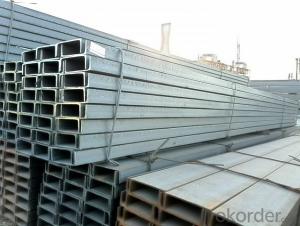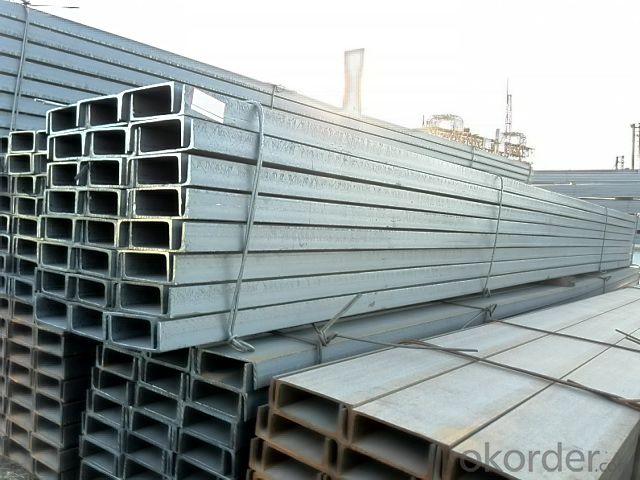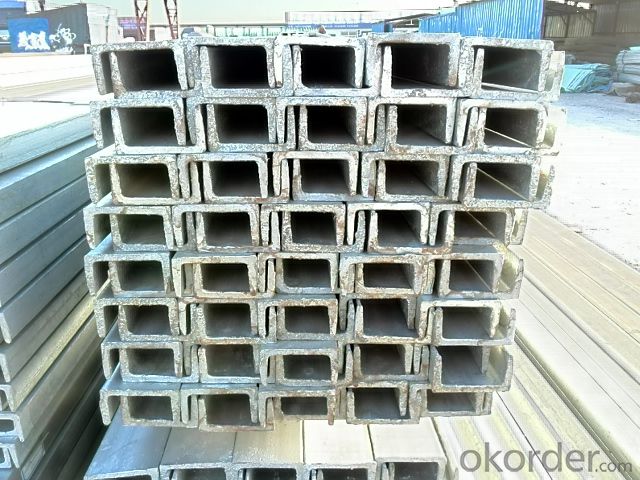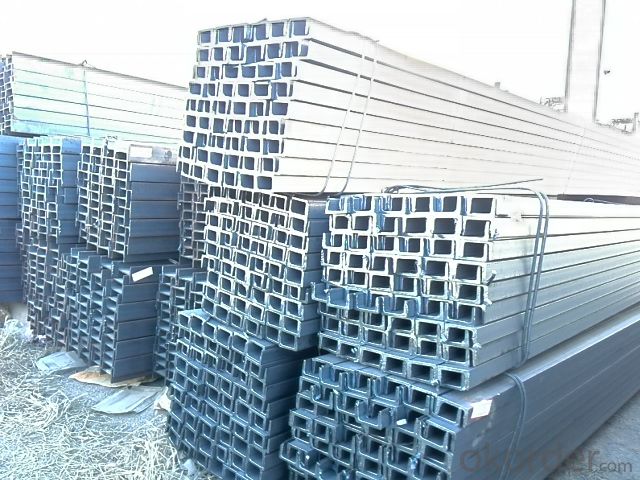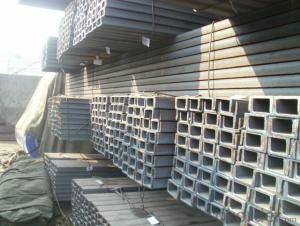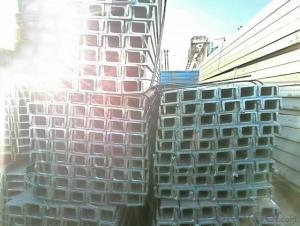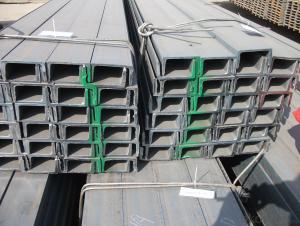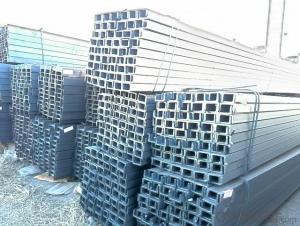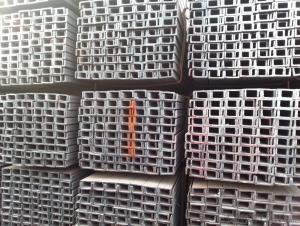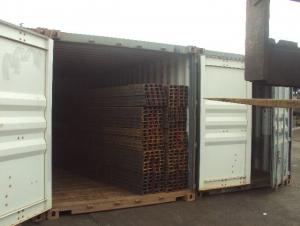JIS Standard U-channels with best quality
- Loading Port:
- Tianjin
- Payment Terms:
- TT OR LC
- Min Order Qty:
- 25 m.t.
- Supply Capability:
- 10000 m.t./month
OKorder Service Pledge
OKorder Financial Service
You Might Also Like
Product Description:
| Minimum Order Quantity: | 25MT | Unit: | m.t. | Loading Port: | Xingang Port |
| Supply Ability: | 120000TON/Year | Payment Terms: | TT or LC |
Product Applications:
JIS Standard U-channels are ideal for structural applications and are widely used in the construction of buildings and bridges, and the manufacturing, petrochemical, and transportation industries.
Product Advantages:
OKorder's JIS Standard U-channels are durable, strong, and resist corrosion.
Main Product Features:
· Premium quality
· Prompt delivery & seaworthy packing (30 days after receiving deposit)
· Corrosion resistance
· Can be recycled and reused
· Mill test certification
· Professional Service
· Competitive pricing
Product Specifications:
Manufacture: Hot rolled
Grade: Q195 – 235
Certificates: ISO, SGS, BV, CIQ
Length: 6m – 12m, as per customer request
Packaging: Export packing, nude packing, bundled
1. We are definitely speciallizing in manufacturing and supplying channel steel as per japanese standard, which is characterised with high mechanical strength and competitive prices.
Original Place | Tangshan, China | Brand Name | UINDA |
Standard | JIS G3192 : 1990 | ||
Material Grade | SS490 | ||
Sizes | 50mm to 200mm | ||
Sales Volume/Year | 3000MT | ||
Destination Area | Middle East, Africa, Southeast Asia | ||
2. The sections in details are as followings in the table-1
JIS U CHANNEL | Standard | Sectional | Dimension |
| Mass: |
| (mm) | (mm) | (mm) | (mm) |
|
50x25 | 50 | 25 | 3.0 | 6.00 | 2.37 |
75X40 | 75 | 40 | 3.8 | 7.00 | 5.30 |
75X40 | 75 | 40 | 4.0 | 7.00 | 5.60 |
75X40 | 75 | 40 | 4.5 | 7.00 | 5.85 |
75X40 | 75 | 40 | 5.0 | 7.00 | 6.92 |
|
|
|
|
|
|
100X50 | 100 | 50 | 3.8 | 6.00 | 7.30 |
100X50 | 100 | 50 | 4.2 | 6.00 | 8.03 |
100X50 | 100 | 50 | 4.5 | 7.50 | 8.97 |
100X50 | 100 | 50 | 5.0 | 7.50 | 9.36 |
|
|
|
|
|
|
125X65 | 125 | 65 | 5.2 | 6.80 | 11.66 |
125X65 | 125 | 65 | 5.3 | 6.80 | 12.17 |
125X65 | 125 | 65 | 5.5 | 8.00 | 12.91 |
125X65 | 125 | 65 | 6.0 | 8.00 | 13.40 |
|
|
|
|
|
|
150x75 | 150 | 75 | 5.5 | 7.30 | 14.66 |
150x75 | 150 | 75 | 5.7 | 10.00 | 16.71 |
150x75 | 150 | 75 | 6.0 | 10.00 | 17.90 |
150x75 | 150 | 75 | 6.5 | 10.00 | 18.60 |
150x75 | 150 | 75 | 6.5 | 10.00 | 24.00 |
|
|
|
|
|
|
200X80 | 200 | 80 | 7.5 | 11.00 | 24.60 |
Table-1
3. The mechanical property of JIS U Channel Steel in the table-2:
Grade | Yield Strength,N/mm² | Extension Strength N/mm² | |||
Thickness of Steel,mm | |||||
≦16 | >16-≦40 | >40-≦100 | >100 | ||
SS490 | ≧285 | ≧275 | ≧255 | ≧245 | 490-610 |
Table-2
4. The chemical composition of JIS U Channel Steel as per SS490 in the table-3
Grade | Element(%) | |||
C | Mn | P | S | |
SS490 | - | - | ≦0.050 | ≦0.050 |
Table-3
FAQ:
Q1: Why buy Materials & Equipment from OKorder.com?
A1: All products offered by OKorder.com are carefully selected from China's most reliable manufacturing enterprises. Through its ISO certifications, OKorder.com adheres to the highest standards and a commitment to supply chain safety and customer satisfaction.
Q2: What makes stainless steel stainless?
A2: Stainless steel must contain at least 10.5 % chromium. It is this element that reacts with the oxygen in the air to form a complex chrome-oxide surface layer that is invisible but strong enough to prevent further oxygen from "staining" (rusting) the surface. Higher levels of chromium and the addition of other alloying elements such as nickel and molybdenum enhance this surface layer and improve the corrosion resistance of the stainless material.
Q3: Can stainless steel rust?
A3: Stainless does not "rust" as you think of regular steel rusting with a red oxide on the surface that flakes off. If you see red rust it is probably due to some iron particles that have contaminated the surface of the stainless steel and it is these iron particles that are rusting. Look at the source of the rusting and see if you can remove it from the surface.
Images:
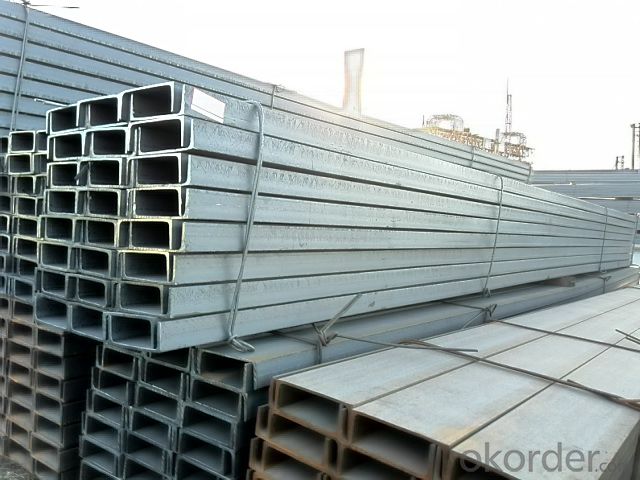
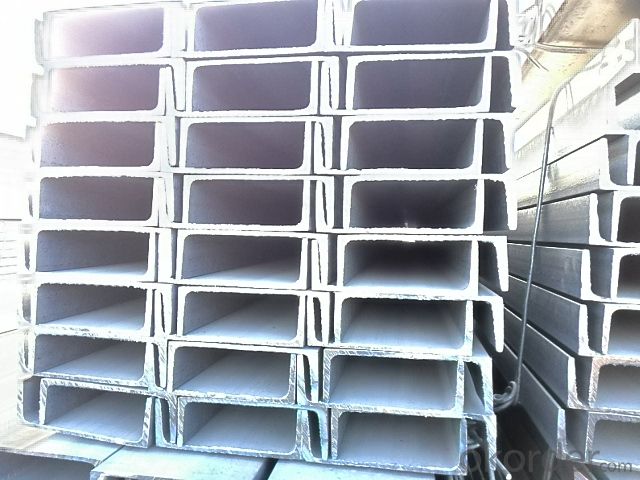
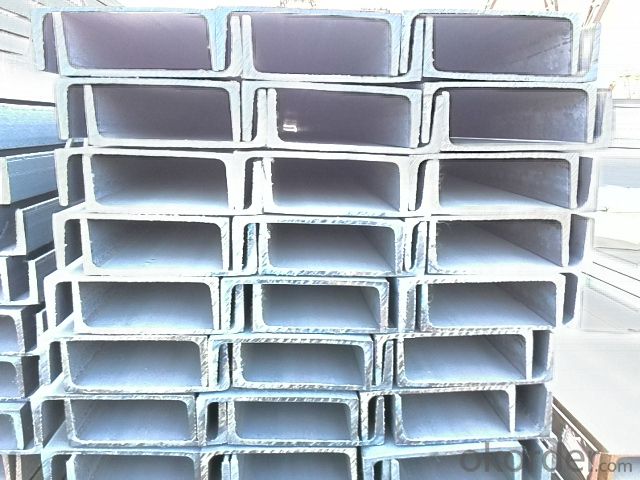
- Q: What is the effect of welding on the properties of steel rebars?
- The properties of steel rebars can be affected by welding in various ways. Firstly, the application of heat during welding can result in localized changes to the microstructure of the material. This, in turn, can lead to alterations in the rebars' mechanical properties, such as hardness and strength. The heat-affected zone near the weld may undergo changes in grain structure, potentially impacting the rebars' ability to withstand tension, compression, or bending forces. Secondly, welding can introduce residual stresses into the rebars due to the expansion and contraction of the material during the heating and cooling phases of the welding process. These residual stresses can potentially impact the rebars' performance under load, making them more prone to cracking or failure. Moreover, improper welding techniques can introduce defects like porosity, inclusions, or lack of fusion. These defects can weaken the rebars, reducing their load-bearing capacity. Additionally, the presence of welding consumables and fluxes can introduce impurities into the rebars, which may compromise their corrosion resistance. In summary, although welding can be an effective means of joining steel rebars, it is essential to consider its potential effects on their properties. To minimize these effects and ensure that the rebars maintain their desired mechanical and structural properties, it is crucial to employ proper welding techniques, such as preheating, controlling heat input, and post-weld heat treatment. Regular inspections and testing of welded rebars are also necessary to guarantee the integrity and safety of the overall structure.
- Q: What are the different types of steel rebars used in foundation construction?
- There are several different types of steel rebars that are commonly used in foundation construction. These include: 1. Mild Steel Rebars: Also known as black bars, mild steel rebars are the most commonly used type of rebars in foundation construction. They have a low carbon content and are easy to work with. Mild steel rebars provide good tensile strength and are cost-effective. 2. High Yield Strength Rebars: These rebars have a higher carbon content and are heat-treated to increase their strength. They are commonly used in areas where extra strength is required, such as in high-rise buildings or in seismic zones. High yield strength rebars offer superior resistance to tensile and compressive forces. 3. Epoxy-Coated Rebars: Epoxy-coated rebars are coated with epoxy resin to protect them from corrosion. They are commonly used in areas where the foundation is exposed to moisture or chemicals, such as in marine or industrial environments. The epoxy coating acts as a barrier, preventing water and other corrosive substances from reaching the steel and causing it to rust. 4. Galvanized Rebars: Galvanized rebars are coated with a layer of zinc to protect them from corrosion. The zinc coating provides excellent resistance to moisture and chemicals, making galvanized rebars suitable for use in areas with high humidity or in contact with concrete that contains chloride ions. They are commonly used in coastal areas or in structures such as bridges and parking garages. 5. Stainless Steel Rebars: Stainless steel rebars are highly corrosion-resistant and are used in environments where other types of rebars may fail due to corrosion. They are commonly used in structures that are exposed to aggressive environments, such as in chemical plants or wastewater treatment facilities. Stainless steel rebars are also used in areas with a high risk of corrosion, such as in coastal or humid regions. Overall, the choice of steel rebars for foundation construction depends on factors such as the specific requirements of the project, the environmental conditions, and the level of corrosion resistance needed. It is important to select the appropriate type of rebar to ensure the longevity and strength of the foundation.
- Q: What is the effect of steel rebars on the formwork design?
- Steel rebars have a significant effect on the formwork design in construction projects. These rebars, also known as reinforcement bars, are used to provide strength and stability to concrete structures. One of the main effects of steel rebars on formwork design is the need for proper positioning and spacing of the rebars within the formwork. The formwork needs to be designed to accommodate the rebars and allow for their proper placement in order to ensure the structural integrity of the concrete element. This may involve creating openings or recesses in the formwork to allow the rebars to pass through. The presence of steel rebars also affects the size and dimensions of the formwork. Since the rebars occupy space within the concrete element, the formwork needs to be adjusted accordingly to accommodate these additional materials. This may require increasing the size or thickness of the formwork to accommodate the desired concrete cover over the rebars. Another effect of steel rebars on formwork design is the consideration of the weight and load-bearing capacity of the formwork system. Steel rebars can add significant weight to the concrete structure, and the formwork needs to be designed to withstand this additional load. This may involve using stronger and more robust materials for the formwork, as well as ensuring proper bracing and support. Furthermore, the presence of steel rebars may also impact the formwork construction process. The formwork needs to be carefully designed to allow for the installation and removal of the rebars without compromising the integrity of the formwork system. This may involve incorporating removable sections or panels in the formwork design to facilitate the placement and removal of the rebars. In conclusion, steel rebars have a significant effect on the formwork design in construction projects. They require careful consideration and planning to ensure proper positioning, spacing, and support within the formwork. The presence of rebars also affects the size, dimensions, weight, and construction process of the formwork system. Overall, proper integration of steel rebars within the formwork design is crucial for the successful construction of durable and structurally sound concrete elements.
- Q: What is the role of steel rebars in industrial flooring construction?
- Steel rebars play a crucial role in industrial flooring construction as they provide reinforcement and strength to the concrete. By being embedded within the concrete slab, rebars help to distribute loads evenly, resist tension forces, and prevent cracking or structural failure. They enhance the durability and longevity of the flooring, making it capable of withstanding heavy loads, impact, and vibrations commonly encountered in industrial settings.
- Q: Can steel rebars be used in structures with high alkaline environments?
- Structures with high alkaline environments, like concrete, generally allow for the use of steel rebars. Nevertheless, it is crucial to take into account the potential for corrosion in such environments. The alkaline nature of concrete forms a protective layer, known as a passive film, on the surface of the steel rebar, which aids in preventing corrosion by reducing contact between the steel and corrosive elements. However, several factors can impact the corrosion resistance of steel rebars in high alkaline environments. These factors encompass the quality of the concrete, the presence of chloride ions (which can disrupt the passive film), the extent of environmental exposure, and the design of the structure. Ensuring that high-quality concrete is used and taking measures to minimize the presence of contaminants that may accelerate corrosion are of utmost importance. In cases where the alkaline environment is highly aggressive or the structure is subject to severe conditions, additional protective measures might be required. These measures can include the application of corrosion-resistant coatings or the implementation of cathodic protection systems to mitigate the risk of corrosion. In conclusion, careful consideration of the specific conditions and appropriate measures are essential when using steel rebars in structures with high alkaline environments. Consulting with structural engineers and corrosion specialists can aid in determining the most suitable approach for utilizing steel rebars in such settings.
- Q: What is the recommended spacing between steel rebars in concrete slabs?
- The recommended spacing between steel rebars in concrete slabs typically ranges from 12 to 18 inches, depending on the specific engineering and structural requirements of the project.
- Q: What is the role of steel rebars in bridge deck construction?
- Steel rebars play a crucial role in bridge deck construction as they provide reinforcement and strength to the structure. They are used to distribute and withstand the load and stresses that the bridge deck may experience, ensuring its stability and durability over time.
- Q: Can steel rebars be used in retaining walls and dams?
- Yes, steel rebars can be used in retaining walls and dams. Steel rebars provide reinforcement and strength to these structures, helping to resist lateral forces and prevent cracking or failure. The use of steel rebars ensures the structural integrity and long-term stability of retaining walls and dams.
- Q: Can steel rebars be used in the construction of museums and art galleries?
- Yes, steel rebars can be used in the construction of museums and art galleries. Steel rebars provide structural support and reinforcement, making them suitable for ensuring the stability and durability of the buildings. Additionally, steel rebars can be designed and installed in a way that minimizes their visual impact, preserving the aesthetic appeal of the museums and art galleries.
- Q: Can steel rebars be used in the construction of pedestrian bridges and walkways?
- Yes, steel rebars can be used in the construction of pedestrian bridges and walkways. Steel rebars provide structural support and reinforcement to concrete, making them suitable for such applications. They enhance the strength and durability of the structures, ensuring their ability to withstand heavy loads and foot traffic.
Send your message to us
JIS Standard U-channels with best quality
- Loading Port:
- Tianjin
- Payment Terms:
- TT OR LC
- Min Order Qty:
- 25 m.t.
- Supply Capability:
- 10000 m.t./month
OKorder Service Pledge
OKorder Financial Service
Similar products
Hot products
Hot Searches
Related keywords
